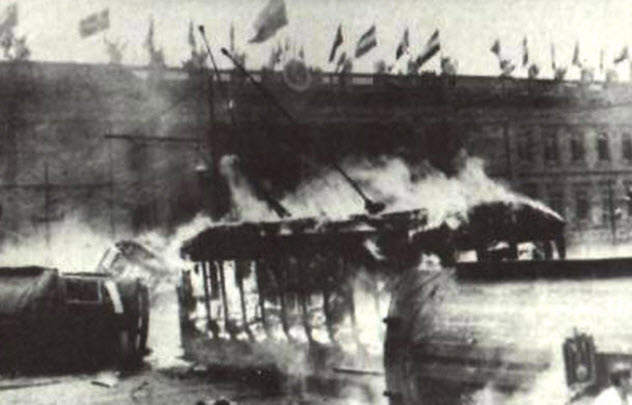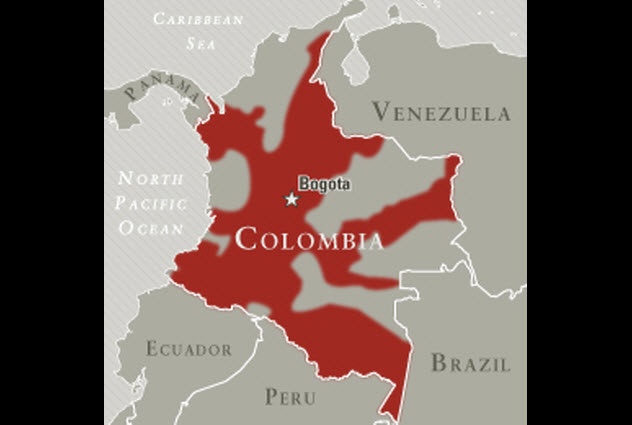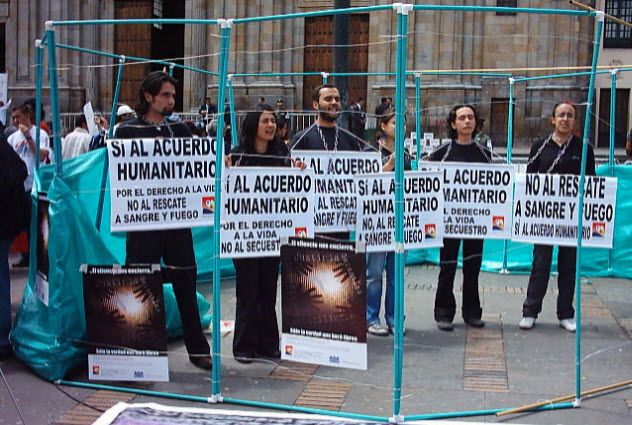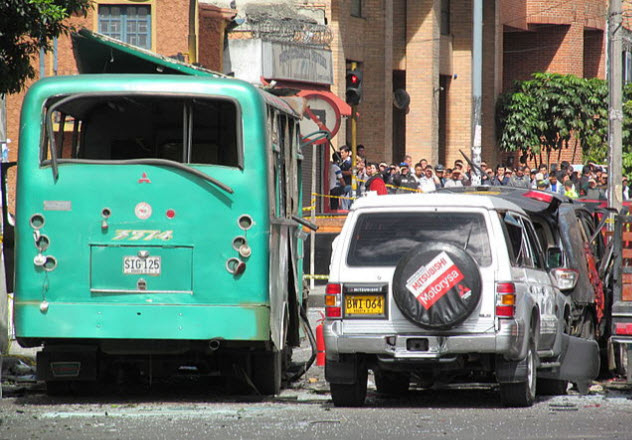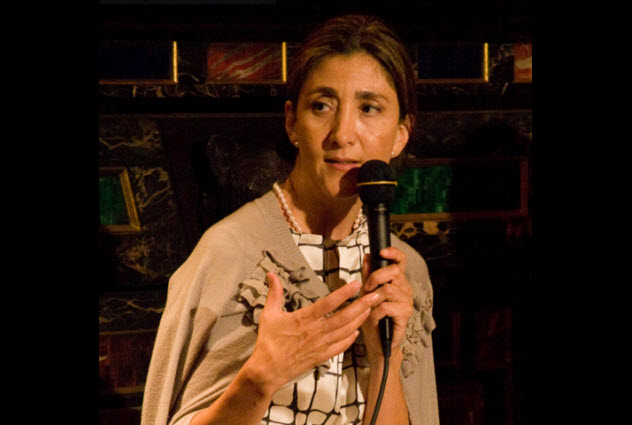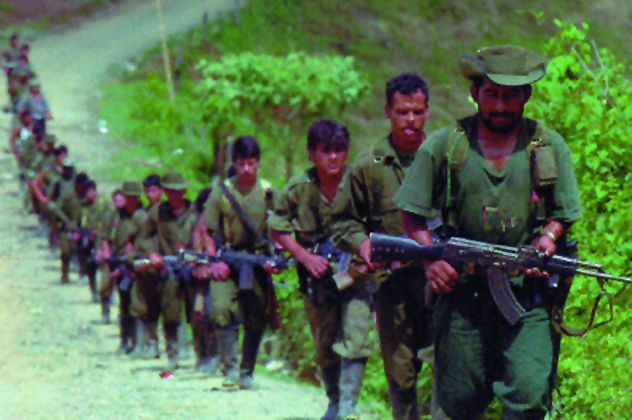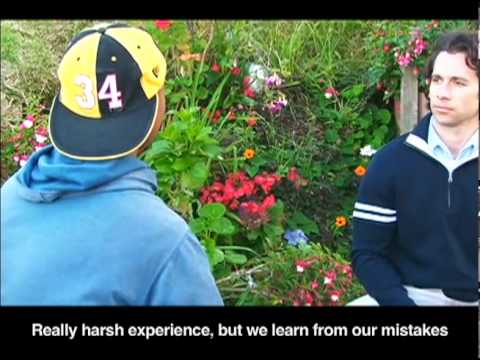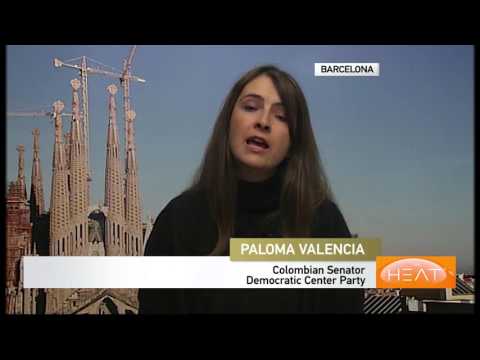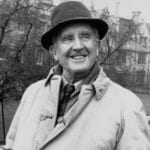An ultraleft Marxist group, FARC has been locked in a bloody conflict with the Colombian government for more than 50 years. Their campaign of terror has left over 250,000 people dead and millions more internally displaced. Historically, FARC hasn’t been the only group contributing to Colombia’s gruesome conflict. At different times, the left-wing ELN, the right-wing AUC, and Pablo Escobar’s Medellin cartel have all played a significant role. But FARC has probably been the scariest. Here’s the story of how they came to be so feared.
10 The Birth Of A Rebel Group
In the 1940s, Colombia was shaken by one of the deadliest civil wars in modern history. The country’s Liberal and Conservative Parties formed death squads that stalked the cities, massacring their opponents. Known as La Violencia, the conflict claimed approximately 200,000 lives in less than a decade. It also created a toxic political situation that would have significant repercussions for years to come. As part of the 1949 peace process, the Liberals and Conservatives agreed to a power-sharing structure that locked all other parties out of government. The Colombian Communist Party responded by telling peasants to set up militias against the state. In the lawless countryside, some of these militias became powerful enough to set up “independent republics,” such as the Republic of Marquetalia. A town of only 1,000 people, the Republic of Marquetalia was no more a viable state than a ranch full of survivalists might be today. Yet the Colombian government was taking no chances. In 1964, they declared war on the rebel enclaves. Marquetalia was bombed into dust. Only 48 of the town’s armed communists managed to escape. Beaten, broke, and traumatized, the wanted peasants regrouped and formed a national Marxist movement. No longer would they be content to control a single town. They would overthrow the murderous state itself under their new name: FARC. Confused as to how fewer than 50 untrained guys with guns could grow to be the biggest terror threat on the continent? For that, you can blame Colombia’s other historic problem.
9 The Seventh Conference And The Drug Trade
Between 1964 and 1982, FARC remained under most governments’ radars. Sure, they attacked military patrols and managed to increase their ranks to 1,000, but they were a minor rebel group in a country riddled with them. Then came the FARC leadership’s seventh conference, and everything changed forever. The conference marked a significant shift in FARC strategy. Until that point, their plan had been to use discontentment within Colombia’s peasant class to create a national movement. By May 1982, it was clear that these tactics weren’t working. So FARC turned to a more lucrative source of income: the cocaine trade. That decision destroyed FARC’s moral claim to represent the oppressed, but it also made them wealthy beyond their wildest dreams. This was the era when Pablo Escobar became the seventh richest man alive by controlling major Colombian drug routes. For a wannabe terror outfit, that sort of money could buy serious influence. Within the next four years, FARC’s ranks would more than triple to 3,600. The conference was also the place where the guerrillas solidified their “centrifugal strategy.” New units attacked new places, constantly spinning off new “fronts” in a conflict that the military simply couldn’t keep up with. In the chaos that followed, FARC planned to surround Bogota and put the capital in a chokehold, draining it of resources. Overwhelmed, the government would then surrender. But even with their new drug money, this strategy was laughably ambitious for FARC. Fast-forward a decade or so, and the world was no longer laughing.
8 Territorial Gains
With their new money, the Marxist group was able to get heavy hitters like the Soviet Union on their side. Throughout the 1980s, FARC soldiers were sent to the USSR to receive combat training. The tactics they learned from the communist regimes transformed them from a bunch of ragtag peasants and drug traffickers into a formidable fighting force. By the 1990s, the guerrillas had seized control of one-third of Colombia’s territory—equivalent to around 380,000 square kilometers (150,000 mi2). If you’re having trouble picturing that, it’s an area of land bigger than Germany. By way of comparison, ISIS held an area of the Middle East roughly one-tenth of that size at their 2014 height. By the end of the 20th century, there was no major city in Colombia that wasn’t surrounded by the guerrillas. All the roads out of Medellin and Cali were blocked, patrolled by fighters on the lookout for wealthy and middle-class people to kidnap. Bogota was virtually isolated from the rest of the country, hemmed in by an advancing rebel force. In 2000, FARC was so certain that the capital was about to fall that they sent their members to public administration courses so they’d be capable of running the country. For Colombians trapped in their cities, these years were a dark time—a time of violence, fear, and round-the-clock terror. By this point, FARC had moved from simply targeting employees of the state to actively hurting civilians.
7 Law 002 And Mass Kidnappings
Although they were a terror group, FARC at their height operated differently from ISIS or other Islamic extremists. While groups like Al-Qaeda focused on killing civilians, FARC preferred to keep them alive. The reason comes down to basic economics. FARC could make a lot more money from kidnapping and holding people for ransom than they could from killing them. This is the logic that led to their terrifying Law 002. By the late 1990s, FARC was already kidnapping 3,000 people a year. In fact, they made nearly as much money from hostages as they did from the drug trade. In 2000, the leadership decided to formalize their policy of abduction by adding it to their revolutionary law code. Written in the 1960s, Law 001 had to do with land reform. Law 002 was far more sinister. Any Colombian with $1 million or more in assets had to immediately give 10 percent of their earnings to FARC. Those who failed to do so would have their family members kidnapped. To show that they were serious, FARC abducted a three-year-old boy and kept him in squalid conditions for 18 months. It had the desired effect. Those who wanted to keep their families safe made the dangerous journey into rebel-held territory and handed over their savings. The group’s power and reach dramatically increased while much of the Colombian population was left beaten and subdued.
6 Indiscriminate Bombings
A forlorn sculpture of a twisted and broken bird can be seen today in Medellin’s San Antonio Park. Known as Pajaro de Paz (“Bird of Peace”), the sculpture commemorates the summer night in 1995 when FARC exploded a bomb in the park during an outdoor concert. Twenty-three young people died, and dozens more were lacerated by flying shrapnel. This gruesome incident was just one in a long line of indiscriminate attacks carried out by the group. While FARC liked to preach the moral high ground and considered themselves averse to killing, the reality is that they weren’t above detonating a bomb or two to get media attention. In 2003, they quietly parked a car laden with explosives beneath a popular nightclub in Bogota and lit the fuse. The blast destroyed the club, killing 32 people—including six children—and seriously injuring over 200 more. At other times, FARC wrote off their civilian casualties as “accidents.” This was putting it politely. In the late 1990s, the IRA helped FARC develop a new type of crude mortar, consisting of little more than a propane tank, dynamite, and shrapnel. The device was extremely deadly but wildly inaccurate by design. The guerrilla group proudly paraded their new toy before reporters. The unspoken message: Civilians should live in fear of being “accidentally” hit by one. In 2002, that’s exactly what happened. A mortar aimed at a rival guerrilla group crashed into a crowded church in the backwater town of Bojaya. In the blink of an eye, 79 innocent lives were extinguished.
5 Attacks On Leaders
Imagine for a moment that it’s 2008 again. As you’re watching Barack Obama’s inauguration on TV, the ceremony is hit by a terrific explosion. A terror group has just launched mortars at the new president, narrowly missing him but killing dozens of civilians. Such an attack seems unimaginable, even in a country that suffered the horrors of 9/11. Yet this is precisely what Colombians witnessed in 2002 at the inauguration of President Alvaro Uribe. Uribe, an extremely hawkish lawyer who advocated fighting dirty against FARC, had a personal beef with the guerrillas. In the 1980s, his father was gunned down in the street by suspected FARC soldiers, who also nearly killed his brother. While FARC has always denied their involvement, their attempt on Uribe’s life at his inauguration showed that they were serious about stopping his presidency. Six mortars were fired at the palace. Three hit government employees. Another three went wild, landing in a nearby slum and killing 11 people. In a bitter irony, the dead slum dwellers were exactly the sort of people whom FARC claimed to represent. Other Colombian leaders also suffered. That same year, the rebels kidnapped presidential candidate Ingrid Betancourt in broad daylight. She was held in a fetid jungle camp for six years. When she was finally freed by the army, her old life had vanished, and she was a psychological mess. The message of these FARC attacks was clear: Even your leaders aren’t safe from us.
4 Killing Soldiers And The Silent War
With even government officials at risk of kidnap and murder by FARC, ordinary soldiers and police officers didn’t stand a chance. The rebels launched attacks designed to inflict maximum military casualties to demoralize Colombia’s soldiers. In 2000, one such attack occurred in the strategic town of Dabeiba near Panama. Around 500 guerrillas swarmed the streets, overwhelming the local forces and killing 32 soldiers and two police officers. When reinforcements arrived by helicopter, FARC managed to shoot one down, killing another 22 soldiers. It was a spectacularly bloody day but all the more remarkable for being unremarkable. In 1998, an attack at El Billar killed over 60 soldiers. In 1996, FARC launched coordinated assaults, killing 80 soldiers in a single weekend. Although grim, this still falls within the expectations of a soldier for his professional life. But FARC excelled at bringing home the horror of combat. In 1999, they launched the “Silent War.” Soldiers home on leave were targeted by rebel assassins and quietly executed. By November 1999, 60 soldiers had been killed this way, murdered in cold blood many miles from the battlefield at one of the few times when they should have felt safe. Those who survived encounters with the rebels were no luckier. FARC detained and kidnapped thousands of soldiers, holding them in conditions so degrading that they have been called crimes against humanity.
3 Child Soldiers
At age 12, most of us were in school with nothing more important to worry about than our homework. For many Colombian children in rural areas, such a life would seem like an idyllic dream. Recruited and brainwashed by FARC, thousands of children spent their 12th year on Earth running drugs, setting IEDs, or performing late-term abortions on pregnant female fighters. Although all sides in the Colombian conflict used child soldiers—including the military—FARC was a particularly effective recruiter. The ranks of FARC and the left-wing ELN accounted for over 70 percent of the child soldiers in the conflict. They started them young, too. At age 12, children could be put in charge of entire units of soldiers. By age 15, they were spending as many as five hours at a time in combat, killing for FARC’s Marxist cause. Those who ran away were hunted down and executed. The recruitment tactics of the group were particularly depressing. FARC targeted children living in poverty, luring them in with promises of treats and small rewards. Demobilized female child soldiers have recalled being given new underwear or makeup kits in return for signing up. For children who had lived their lives in backbreaking poverty and who didn’t necessarily understand what they were signing up for, such pathetic treats could really seem worth the risk to their lives.
2 A Failed Peace
FARC’s greatest triumphs came at the end of the 1990s and the dawn of the 2000s. That was the era of the Silent War, the era when they could bomb inaugurations and create the hideous Law 002. It may surprise you to learn what the Colombian government was doing during this period of wide-ranging terrorism. They were negotiating for peace. Obviously, peace is a noble goal. But there’s negotiating for peace, and then there’s doing a Neville Chamberlain. President Andres Pastrana Arango sadly chose the latter course. During the 1999–2002 peace talks with FARC, Pastrana agreed to the creation of a “safe zone” where the group could do whatever they liked. The size of Switzerland, the zone was essentially a FARC ministate. Colombian state employees were not allowed in. Planes were not permitted to fly overhead, and no attacks could take place. Pastrana hoped to show FARC that he was serious about peace and convince them to disarm. The rebels played him like a fool. Not long after the zone was established, FARC launched a gigantic attack, capturing an entire town and executing 60 of its police officers. When Pastrana did nothing, FARC grew even bolder. At a winter peace conference in Sweden, Pastrana suggested a bilateral cease-fire for the holidays. The rebels did the exact opposite, launching a new offensive. When Pastrana complained, they told him that he needed to purge his ranks of soldiers loyal to the right-wing paramilitary groups that were operating in Colombia. Pastrana agreed. Yet FARC kept killing. By 2002, it was clear that the rebels had never wanted peace. They used the talks and the safe zone as a cover for building a bigger army. Yet Pastrana kept giving ground. When the ELN joined the “talks,” Pastrana gave them their own “safe zone” to abuse. By the time he left office, FARC was at the height of their power, and there was no peace deal in sight.
1 The Three-Way War
Around this time, another big player stepped onto the stage of Colombia’s conflict. The AUC was an extreme right-wing paramilitary group that had risen from the ashes of Escobar’s old Medellin cartel. Formed in 1993, their official mission was to protect the army and Colombia’s wealthy from FARC and the ELN. The AUC was even tolerated by President Uribe, who had close links with the group. In reality, though, their 30,000 members were raging psychopaths. If FARC was evil incarnate, the AUC was Satan himself. The group targeted villages that were “loyal” to FARC—a polite way of saying that the villagers paid protection money to the left-wing rebels to spare their lives. The AUC would round up the entire village and execute everyone in the most gruesome ways possible. People had their heads bashed in with sledgehammers. Children had their limbs chainsawed off. Their actions were meant to be a warning to FARC. Instead, they provoked a deadly, three-way war. In 2001, FARC and the AUC began a battle for supremacy that laid waste to the Colombian countryside. At the same time, FARC and the ELN fell out over illegal mining opportunities and started their own conflict. The bruising three-way battle between rebel groups sucked in hundreds of thousands of civilians. In one pitched battle in 2002, at least 200 people died around the town of Campamento in the province of Antioquia as FARC and the AUC warred for territory. For ordinary Colombians, these days must have felt like the End Times. The fighting caused millions to flee their homes, resulting in about six million Colombians eventually becoming refugees in their own country. Before the complete collapse of Syria in 2013, this was the highest number of refugees anywhere on Earth. In 2006, the AUC finally demobilized under a peace deal with Uribe’s government. By this time, FARC had been badly damaged by the onslaught of both the paramilitaries and the Colombian army. FARC was weaker than it had been in decades, but the cost to achieve this was enormous. During their brief reign, the AUC had killed more civilians than FARC had in 40 years. By tolerating the existence of the AUC, Uribe had helped to bring FARC to its knees. But he’d also done a deal with the devil, one for which ordinary Colombians were forced to pay the price.
+ Disarmament
In 2012, President Juan Manuel Santos, Uribe’s successor, stunned his old mentor by restarting peace talks with FARC. At the time, FARC was weakened, and it was widely expected that Santos would keep hammering them as Uribe had. However, Santos seemingly had little appetite for the shocking human rights violations of his predecessor. In the face of enormous public skepticism, peace negotiations began once again. Incredibly, they seem to have worked this time. In January 2016, it was announced that conflict violence had reached its lowest point in Colombia since FARC was formed in 1964. As of early February 2016, the rebels have a cease-fire in place, and FARC attacks are at an all-time low. A peace process partially based on Britain’s Good Friday Agreement with the IRA is being implemented. Human rights abusers from FARC and the military have indicated that they’re willing to serve jail time for their horrendous crimes. In a sign of just how far things have come, Santos even asked the US to remove FARC from Washington’s terror watch list. The US declined, saying that it would reconsider once FARC had disarmed. Both sides are expected to agree to a peace deal in the first half of 2016, ending a 52-year civil war. When that happens, one of the most fearsome terrorist organizations on Earth will formally cease to exist. Although many have criticized the peace talks, there is no doubt that FARC’s demobilization will make life better for millions of ordinary Colombians.
